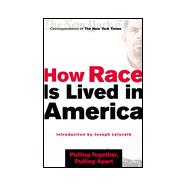
| Introduction | ix | ||||
|
|||||
| PART I: THE STORIES | |||||
|
3 | (20) | |||
|
|||||
|
23 | (18) | |||
|
|||||
|
41 | (16) | |||
|
|||||
|
57 | (22) | |||
|
|||||
|
79 | (18) | |||
|
|||||
|
97 | (18) | |||
|
|||||
|
115 | (18) | |||
|
|||||
|
133 | (18) | |||
|
|||||
|
151 | (20) | |||
|
|||||
|
171 | (18) | |||
|
|||||
|
189 | (22) | |||
|
|||||
|
211 | (20) | |||
|
|||||
|
231 | (20) | |||
|
|||||
|
251 | (18) | |||
|
|||||
|
269 | (18) | |||
|
|||||
| PART II: THE CONVERSATIONS | |||||
|
287 | (16) | |||
|
303 | (14) | |||
|
317 | (48) | |||
| Appendix: The New York Times Poll on Race: Optimistic Outlook But Enduring Racial Division | 365 |
The New copy of this book will include any supplemental materials advertised. Please check the title of the book to determine if it should include any access cards, study guides, lab manuals, CDs, etc.
The Used, Rental and eBook copies of this book are not guaranteed to include any supplemental materials. Typically, only the book itself is included. This is true even if the title states it includes any access cards, study guides, lab manuals, CDs, etc.
Excerpted from How Race Is Lived in America: Pulling Together, Pulling Apart by Correspondents of The New York Times
All rights reserved by the original copyright owners. Excerpts are provided for display purposes only and may not be reproduced, reprinted or distributed without the written permission of the publisher.